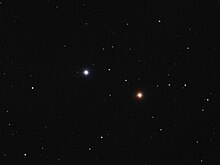Nu1 Bootis
Nu1 Bootis (ν1 Bootis / ν1 Boo) est une étoile géante de la constellation boréale du Bouvier. Elle est visible à l’œil nu avec une magnitude apparente de +5,02[2], bien qu'apparaissant peu brillante. L'étoile est distante d'environ ∼ 950 a.l. (∼ 291 pc) du Soleil[1] et elle s'en rapproche avec une vitesse radiale héliocentrique de −11 km/s[4]. À sa distance, sa magnitude visuelle est diminuée de 0,13 en raison du facteur d'extinction créé par la poussière interstellaire présente sur le trajet de la lumière émise par l'étoile[11]
| Ascension droite | 15h 30m 55,76022s[1] |
|---|---|
| Déclinaison | +40° 49′ 58,9709″[1] |
| Constellation | Bouvier |
| Magnitude apparente | +5,02[2] |
Localisation dans la constellation : Bouvier | |
| Type spectral | K4,5 IIIb Ba0,4[3] |
|---|---|
| Indice U-B | +1,91[2] |
| Indice B-V | +1,59[2] |
| Vitesse radiale | −11,12 ± 0,16 km/s[4] |
|---|---|
| Mouvement propre |
μα = +10,106 mas/a[1] μδ = −8,183 mas/a[1] |
| Parallaxe | 3,446 2 ± 0,132 1 mas[1] |
| Distance | 290,175 ± 11,123 pc (∼946 al)[1] |
| Magnitude absolue | −2,22[5] |
| Rayon | 38 ± 2 R☉[6] |
|---|---|
| Gravité de surface (log g) | 1,15 ± 0,17[7] |
| Luminosité | 1 626 L☉[8] |
| Température | 3 917 ± 27 K[7] |
| Métallicité | +0,00 ± 0,06 [Fe/H][7] |
| Rotation | 4,2 km/s[9] |
Désignations
ν1 Bootis est une étoile géante rouge de type spectral K4,5 IIIb Ba0,4[3]. La notation « Ba0,4 » présente dans son suffixe indique qu'il s'agit d'une étoile à baryum[12], ce qui signifie que son atmosphère a été enrichie par le processus s en certains éléments qui ont probablement été fournis par un compagnon en orbite qui est désormais devenu une naine blanche[13]. L'étoile géante est environ 38 fois plus grande que le Soleil[6]. Elle est 1 626 fois plus lumineuse que le Soleil[8] et sa température de surface est de 3 917 K[7].
Notes et références
modifier- (en) Cet article est partiellement ou en totalité issu de l’article de Wikipédia en anglais intitulé « Nu1 Boötis » (voir la liste des auteurs).
- (en) A. G. A. Brown et al. (Gaia collaboration), « Gaia Data Release 2 : Summary of the contents and survey properties », Astronomy & Astrophysics, vol. 616, , article no A1 (DOI 10.1051/0004-6361/201833051, Bibcode 2018A&A...616A...1G, arXiv 1804.09365). Notice Gaia DR2 pour cette source sur VizieR. .
- (en) H. L. Johnson et al., « UBVRIJKL photometry of the bright stars », Communications of the Lunar and Planetary Laboratory, vol. 4, no 99, (Bibcode 1966CoLPL...4...99J).
- (en) Philip C. Keenan et Raymond C. McNeil, « The Perkins catalog of revised MK types for the cooler stars », Astronomy & Astrophysics Supplement Series, vol. 71, , p. 245 (DOI 10.1086/191373, Bibcode 1989ApJS...71..245K).
- (en) J. H. J. de Bruijne et A.-C. Eilers, « Radial velocities for the HIPPARCOS-Gaia Hundred-Thousand-Proper-Motion project », Astronomy & Astrophysics, vol. 546, , p. 14, article no A61 (DOI 10.1051/0004-6361/201219219, Bibcode 2012A&A...546A..61D, arXiv 1208.3048).
- (en) Ricardo P. Schiavon, « Population Synthesis in the Blue. IV. Accurate Model Predictions for Lick Indices and UBV Colors in Single Stellar Populations », The Astrophysical Journal Supplement Series, vol. 171, no 1, , p. 146–205 (DOI 10.1086/511753, Bibcode 2007ApJS..171..146S, arXiv astro-ph/0611464).
- (en) Tyler E. Nordgren et al., « Stellar Angular Diameters of Late-Type Giants and Supergiants Measured with the Navy Prototype Optical Interferometer », The Astronomical Journal, vol. 118, no 6, , p. 3032–3038 (DOI 10.1086/301114, Bibcode 1999AJ....118.3032N, lire en ligne).
- "(en) Ph. Prugniel, I. Vauglin et M. Koleva, « The atmospheric parameters and spectral interpolator for the MILES stars », Astronomy & Astrophysics, vol. 531, , A165 (DOI 10.1051/0004-6361/201116769, Bibcode 2011A&A...531A.165P, arXiv 1104.4952).
- (en) I. McDonald, A. A. Zijlstra et M. L. Boyer, « Fundamental Parameters and Infrared Excesses of Hipparcos Stars », Monthly Notices of the Royal Astronomical Society, vol. 427, no 1, , p. 343–57 (DOI 10.1111/j.1365-2966.2012.21873.x, Bibcode 2012MNRAS.427..343M, arXiv 1208.2037).
- (en) J. R. De Medeiros et al., « Rotation and lithium in single giant stars », Astronomy & Astrophysics, vol. 363, , p. 239–243 (Bibcode 2000A&A...363..239D, arXiv astro-ph/0010273).
- (en) * nu.01 Boo -- Star sur la base de données Simbad du Centre de données astronomiques de Strasbourg..
- (en) B. Famaey et al., « Local kinematics of K and M giants from CORAVEL/Hipparcos/Tycho-2 data. Revisiting the concept of superclusters », Astronomy & Astrophysics, vol. 430, no 1, , p. 165–186 (DOI 10.1051/0004-6361:20041272, Bibcode 2005A&A...430..165F, arXiv astro-ph/0409579).
- (en) A. E. Gomez et al., « Absolute magnitudes and kinematics of barium stars », Astronomy & Astrophysics, vol. 319, , p. 881 (Bibcode 1997A&A...319..881G).
- (en) P. P. Eggleton et A. A. Tokovinin, « A catalogue of multiplicity among bright stellar systems », Monthly Notices of the Royal Astronomical Society, vol. 389, no 2, , p. 869–879 (DOI 10.1111/j.1365-2966.2008.13596.x, Bibcode 2008MNRAS.389..869E, arXiv 0806.2878, lire en ligne).
Liens externes
modifier- (en) Nu1 Bootis sur la base de données Simbad du Centre de données astronomiques de Strasbourg.
- (en) Bright Star Catalogue, « HR 5763 », sur Alcyone

